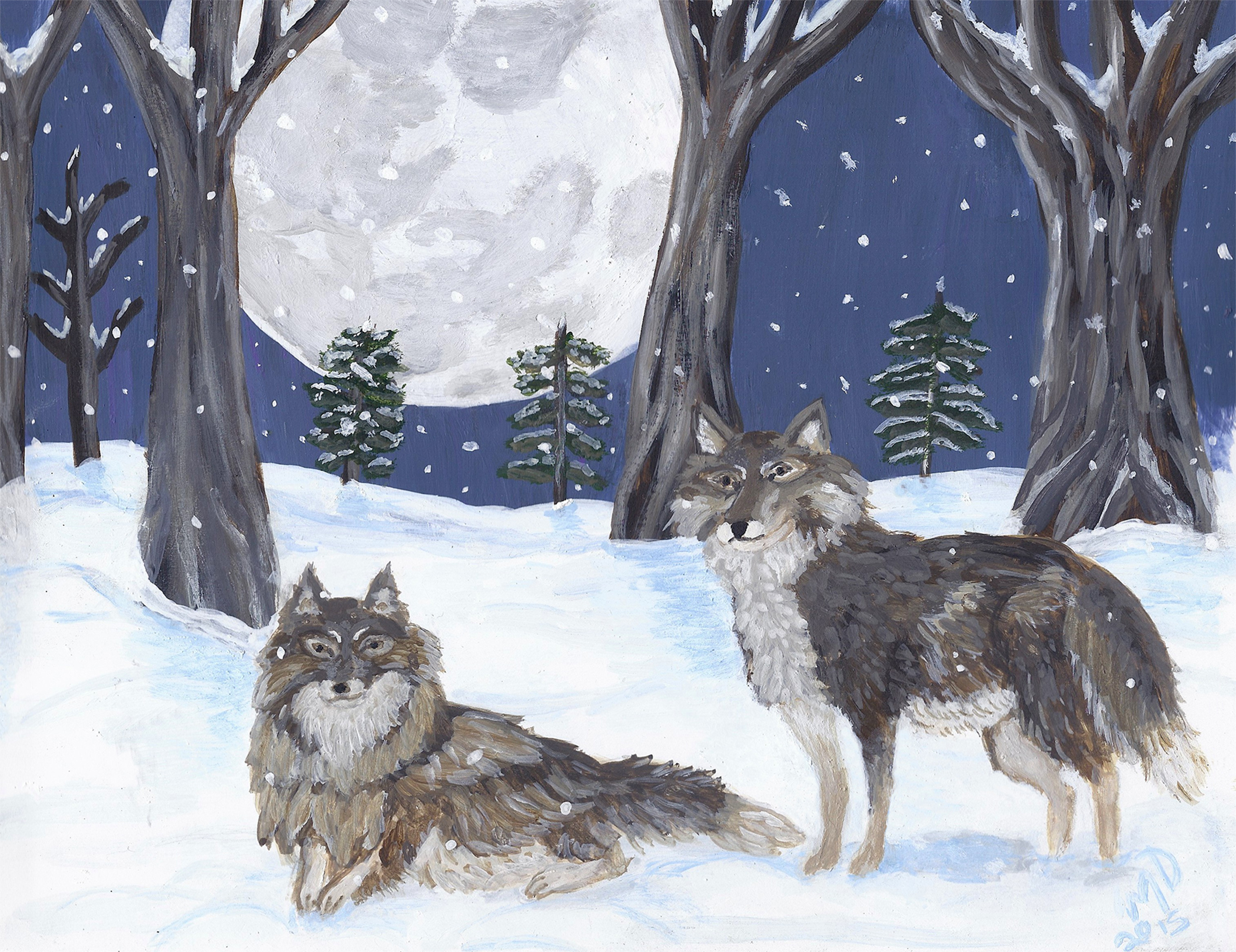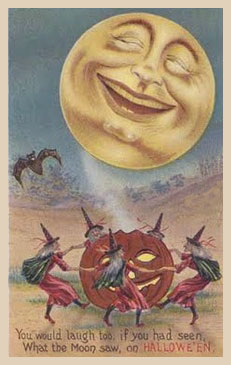
The Full Moon and the Wolves
-By Angelique Duncan
The full moon of January is the Wolf Moon. It was titled by Native Americans who named each moon in the calendar for attributes that occurred in nature during that lunar cycle. While other animals take shelter and hibernate during the harsh cold of January, the wolves remain active, searching for food. It was considered very dangerous to go out during a full Wolf Moon for fear of wolf attacks. The January Wolf Moon was given its namesake for the baying of wolves that could be heard over the silence of Winter.
Wolves in mythology have been seen as leaders of the animal realm. Revered for their intelligence and tremendous hunting skills, relentless loyalty to protect their pack, nurturing instinct to their young and feared for their strength and ferocity in attack. The wolf in Native American, as well as Norse, Germanic and Slavic cultures was seen as a magnificent warrior, either to be respected or to be feared.
Many Native American tribes believed that if one were to wear a wolf pelt in battle they would channel the wolves fighting instinct and technique to be as the wolf. Those who wore animal pelts in battle were known as “Skin Walkers”, guided by their animal spirit.
The concept of “Skin Walkers” that existed in other cultures may be where the legends of the Werewolf beginnings. Although there are many possible origins and mythologies surround the half man half wolf legend. None seem to be confirmed and the history is cloudy. The stories exist in European regions of wolf warriors, half wolf- half man predators, werewolves and changelings, however recorded historical documents prior to the 13th century have either been destroyed, lost or suppressed from the public sphere of history. As Christianity spread across Europe much of what had been believed to have been recorded in Pagan histories was either left out or re-written by the church and became the stuff of myths and rumors.
Some of the earliest recorded wolf legends go back to the Greek mythology of Lycaon, who was changed into a wolf as punishment for eating his child. The Romans had many myths linked to wolves as both nurturing mother spirits and as predators’.
The wolves are a prominent figure in Norse mythology, most originating from the story of Fenrir. Fenrir was one of three sons of Loki. It was feared he would devour the rehlm and was captured. However he continued to grow huge in captivity. As the legend goes, dwarves where commissioned to create a special chain to bind him to a boulder were a sword was placed in Fenrirs jaw to keep him form attacking. From his frothing saliva a river was formed.
Stories of Werewolf like beings appear in legends from Germanic Pagans and Slavic regions as well in Norse mythology. Like the “Skin Walkers” of the Native American tales, stories are told of vicious Wolf Warriors. Men who would wear the skins of wolves and transform into wolf creatures who were animalistic in their fighting, and said to be stronger and resilient to pain. It is written that they were nearly impossible to take down in battle as if immortal.
In Irish folklore stories are passed down of the Laignach Faeland. They were half man half wolf beast who acted as mercenaries for hire. They would fight for a bounty of the flesh of small children and babies. Much fear and destruction was associated with the Laignach Faeland. They were large, fierce warriors who were unrelenting in battle.
Through out the history of Europe during the 14th through 16th centuries reports were made of Werewolf or shape-shifter attacks. The accusations were of wolf creatures that hunted humans. The victims were brutally attacked, often dis-membered, gutted and left for dead. In some instances the blood had been drained from their bodies. No wolf creatures were ever identified or confirmed and the predators never caught in these mysterious deaths.
During the witch trials in France of the 14th to 15th centuries accusations were made of shape shifting witches. Allegations were also made of witches consorting with Werewolves. In Hungary trials were set against Werewolves as late as the 18th century. It was believed that Werewolves, Witches and Vampires were responsible for bazaar deaths of humans and the mass disappearance of livestock.
In many early Werewolf legends it is believed that the wolf shape-shifting and transformation happened most prevalently during the Winter Solstice and during Ostera or Easter during a full moon. Mythologies from France, Italy and Germany stated that one could be metamorphosed into a wolf by sleeping outside in ta full moon on a designated Wednesday or Friday during the Summer months. It was believed that one would transform into a Werewolf by becoming naked and wearing a wolf skin pelt or belt. Some believed drinking rainwater collected in the track of a wolf would bring on Werewolf changes. Legends were spread that drinking water from enchanted steams during a full moon or a beer specially made from enchanted spring water would cause the affliction of wolf transformation. Some stories tell of witch spells that were cast to change the victim.
The commonly accepted way to stop a Werewolf is by use of a silver bullet or silver weapon. This comes from 18th century folklore of Germany and was reinforced by 19th century literature. The notion became popular and has remained part of Werewolf lore. Early beliefs were that scolding an infected victim or running it to the point of exhaustion could stop a Werewolf. Others believed that looking the beast in the eye and repeating their Christian given name three times would exorcise the wolf out of the infected. Some held that the only cure to Werewolf-ism was to fully convert to Christianity.
There are scientific explanations that could explain what may have been confused for shape shifting by an uneducated populace of the earlier centuries. Such conditions would include hypertrichosis, a condition in which one experiences abnormal thick hair growth that covers the body. Some victims of the condition experience adult onset, which would give the illusion that they are changing into an animal from their human form since they did not have the hair growth in childhood. Another misunderstood medical condition was photosensitivity in which one cannot go out into sunlight. A full moon would offer someone suffering from the condition an ability to move at night with out harm and bolster beliefs of nocturnal animal behaviors attributed to humans. Infection with rabies may be another condition that would have been confused with possession by wolf. The symptoms of a bite received from a rabies infected animal could have been confused for transformation by one who did not have an understanding of the disease.
We do not know if Werewolves existed or still do. The evidence is not conclusive or well documented to make the case either way. However the legends and stories do exists and are a part of our modern culture. Wolves are a deep seeded component of the history of such great cultures as the Norse, the Italians as well as France and Germany and an important animal in Native American beliefs.
Be warned, the next Wolf Moon occurs January 5th 2015. If you happen to about outside and you here the distant howl of a wolf take heed. It could be a transformed Werewolf, the ancient cry of a forgotten Wolf Warrior or the ghost of a noble animal Wolf Spirit calling for his pack.
Illustration “Full Wolf Moon” appears courtesy of Michelle Angelique Duncan-Twilight Faerie.
Angelique Duncan is proprietor of Twilight Faerie Nostalgic and Capricious Objects. Check out her artist page to find links to her shops and vintage inspired traditional holiday art. Visit again next month for more traditions and folklore.

